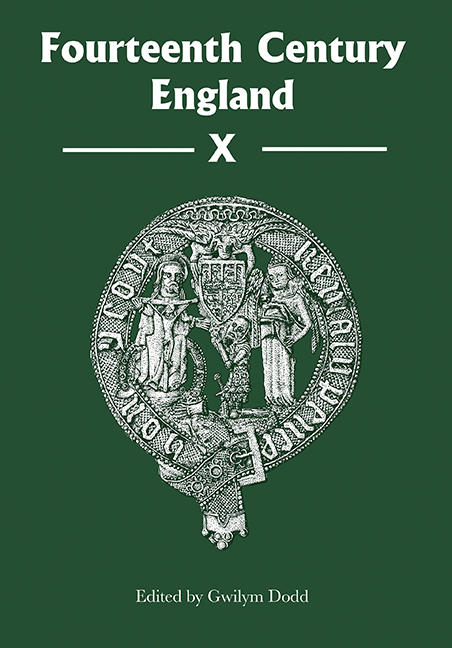Book contents
- Frontmatter
- Contents
- List of Illustrations
- Contributors
- Preface
- Abbreviations
- ‘Bought by the King Himself’: Edward II, His Chamber, His Family and His Interests in 1325–26
- Parliament in the Reign of Edward II
- The Representation of the Clergy in Parliament
- Feeding Mars: Military Purveyance in the Long Fourteenth Century
- ‘Unnatural in Body and a Villain in Soul’: Rape and Sexual Violence towards Girls under the Age of Canonical Consent in Late Medieval England
- Marriage and Inheritance: The Element of Chance in the Development of Lay Estates in the Fourteenth Century
- Mary Percy and John de Southeray: Wardship, Marriage and Divorce in Fourteenth-Century England
- Richard II's Kingship at St Stephen's Chapel, Westminster, 1377–99
- Bodies in Constant Motion: The Burials and Reburials of the Plantagenet Dynasty, c. 1272–1399
- Fourteenth Century England Issn 1471–3020
Feeding Mars: Military Purveyance in the Long Fourteenth Century
Published online by Cambridge University Press: 03 July 2019
- Frontmatter
- Contents
- List of Illustrations
- Contributors
- Preface
- Abbreviations
- ‘Bought by the King Himself’: Edward II, His Chamber, His Family and His Interests in 1325–26
- Parliament in the Reign of Edward II
- The Representation of the Clergy in Parliament
- Feeding Mars: Military Purveyance in the Long Fourteenth Century
- ‘Unnatural in Body and a Villain in Soul’: Rape and Sexual Violence towards Girls under the Age of Canonical Consent in Late Medieval England
- Marriage and Inheritance: The Element of Chance in the Development of Lay Estates in the Fourteenth Century
- Mary Percy and John de Southeray: Wardship, Marriage and Divorce in Fourteenth-Century England
- Richard II's Kingship at St Stephen's Chapel, Westminster, 1377–99
- Bodies in Constant Motion: The Burials and Reburials of the Plantagenet Dynasty, c. 1272–1399
- Fourteenth Century England Issn 1471–3020
Summary
One of the most important elements of a successful military operation, whether a singular endeavour such as a pitched battle or siege, or an entire campaign, is the logistical arrangements behind the scene. Without paying attention to the ‘nuts-and-bolts’ of supply, military tactics on the ground cannot succeed unless by sheer accident. The most basic requirement of an army is a food supply and yet feeding medieval armies was always challenging. Logistical systems had to be sophisticated to ensure the sufficient supply of provisions to the military, both for armies on the move and garrisons of castles and towns. The increasing scale of warfare under Edward I and his successors meant that this crucial strategic component could no longer rely on haphazard foraging or similarly unpredictable methods; instead, an ample store of provisions needed to be reliably available. The prerequisite for this was an administration adequately centralised with the authority to require and oversee effective systems that in modern parlance would be called military supply line management. What emerged in the late thirteenth century was an expanded use of purveyance – the compulsory sale of foodstuffs and other necessary supplies to the king's officers – which was believed to be a royal prerogative, and, as such, could be demanded as a right. Its nature has created thorny questions for historians about its efficacy and relative advantage for late medieval logistics. The administrative histories nearly fifty years ago tended to emphasise the system's bureaucratic complexity and sophistication. Subsequent twentieth- century scholarship, reflecting a social history flavour, focused on the onerousness of the system and the resulting popular outcry. More recent works have traced the procedure itself in detail, tempering the overly pessimistic conclusions of earlier historians by once again demonstrating the administrative intricacy visible in the system. This essay seeks to explore the middle ground, recognising that the system was inherently valuable and productive for the three Edwards who relied on it, but also riddled with corrupt practices that weakened its ability to function according to its ideal. This characteristic of purveyance was evident even from its earliest employment under Edward I.
Edward I
Edward I's reign was a mixture of energetic administrative and juridical reform, and vigorous military action, some of which ended in successful conquest, while the majority left a legacy of drawn-out conflict and debt to his heirs.
- Type
- Chapter
- Information
- Fourteenth Century England , pp. 67 - 88Publisher: Boydell & BrewerPrint publication year: 2018
- 1
- Cited by

